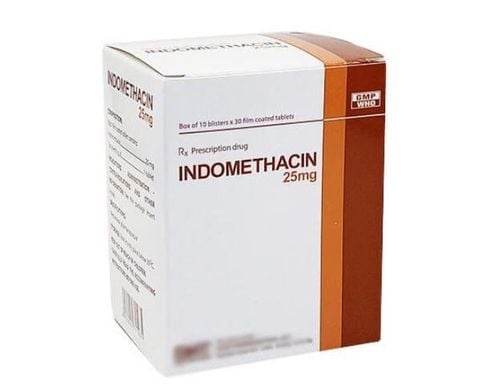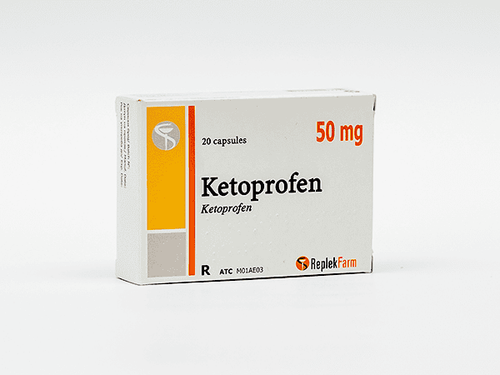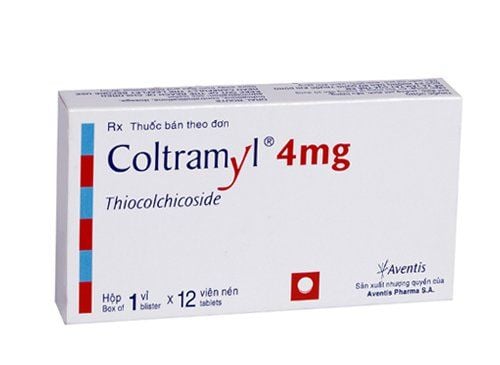This is an automatically translated article.
Indomethacin belongs to the group of non-steroidal anti-inflammatory pain relievers, indicated in the treatment of diseases such as ankylosing spondylitis, rheumatoid arthritis, Reiter's syndrome... Let's learn about dosage and precautions when Use the drug Indomethacin through the article below.
1. Uses of Indomethacin
1.1. Indications to use Indomethacin Drugs Indomethacin contains the active ingredient Indomethacin - belongs to the group of non-steroidal anti-inflammatory pain relievers. Indications for indomethacin in the treatment of the following diseases:
Inflammatory joint diseases such as ankylosing spondylitis, rheumatoid arthritis, Reiter's syndrome; Osteoarthritis in pathologies or when treating the period of increased inflammation and pain of the rheumatic muscles. However, the treatment time is short; Pain after surgery; Migraine headaches with multiple daily attacks of pain in the forehead, eyes, and temples; Exacerbation of gout ; Used in neonates to close the ductus arteriosus in premature infants. 1.2. Pharmacodynamics Analgesic drug indomethacin is a derivative of indolacetic acid, which acts mainly by inhibiting the enzyme prostaglandin synthetase and preventing the production of prostaglandins, thromboxane as well as products of the enzyme cyclooxygenase.
The platelet aggregation inhibitory effect of indomethacin disappears within 24 hours of dosing and the clotting time returns to baseline. The inhibitory effect of prostaglandin E2, D2 and I2 synthesis of the drug reduces renal perfusion.
1.3. Pharmacokinetics The pharmacokinetics of indomathacin are described as follows:
Absorption: The drug is well absorbed from the gastrointestinal tract (approximately 90% of a dose is absorbed in 4 hours with 100% bioavailability). Peak plasma concentrations of the drug are reached 2 hours after oral administration and they are dose dependent. In the case of food, absorption of the drug is reduced, but bioavailability is not changed. Distribution: The plasma protein binding of the drug is high (about 99%). In particular, the drug penetrates into the joint fluid at a rate of about 20% compared to the concentration in plasma, the drug crosses the blood-brain barrier, the placenta and is present in breast milk and saliva. Metabolism: Drug metabolism occurs mainly in the liver by demethylation and fat reduction. The half-life (t1/2) of indomethacin in plasma varies from 2 to 11 hours. Elimination: The half-life of the drug is from 2.5 to 11.2 hours. Of which about 60% of the dose is excreted in the urine as unchanged or metabolized, about 33% of the dose is excreted in the feces. The half-life of indomethacin in premature infants is 10-20 times longer than in adults.

Indomethacin là một trong các loại thuốc giảm đau kháng viêm
2. Dosage and how to use Indomethacin
2.1. Dosage of Indomethacin The dose of Indomethacin pain reliever depends on the condition and age of the patient. Specifically as follows:
- Adults:
Treatment of diseases of joints and muscles: Use 25mg/time x 2-3 times/day, drink with meals. In case the drug is well tolerated, the dose can be increased by 25-50 mg/day to a maximum of 150-200 mg/day. A dose of 100mg orally or rectally at bedtime reduces pain at night and reduces stiffness in the morning upon awakening; Chronic paroxysmal migraine: Use 25mg/time x 3 times/day; Treatment of acute gout attacks: Use 50mg/time x 3 times/day. Avoid the combination of Indomethacin and aspirin; Treatment of dysmenorrhea: The dose can be up to 75 mg/day; Treatment of juvenile chronic arthritis: Use 1 - 2.5 mg/kg/day, divided into 3-4 times orally. The maximum dose is 4 mg/kg/day or not more than 150 mg/day; Use after orthopedic surgery: Dose 100 - 150mg / day, divided into several times until the symptoms are relieved. - Children:
Closure of the ductus arteriosus in premature infants: Short treatment with 3 intravenous doses 12-24 hours apart, each infusion from 20 to 30 minutes. The dose of indomethacin depends on the age of the infant, and the next dose is based on the age of the child when the first dose was given. Specifically, infants under 48 hours of age injected with the first dose of indomethacin over 200 micrograms/kg body weight; dose 2 injection 100 microgram/kg body weight. For infants from 2 to 7 years old, inject 3 doses, the first dose is 200 micrograms/kg body weight, the second dose is 250 micrograms/kg body weight; Juvenile rheumatoid arthritis: For children 2 years of age and older, the starting dose of indomethacin is 1-2 mg/kg/day in divided doses. Dosage was gradually increased until response to treatment (maximum 3 mg/kg/day). When symptoms subside, the dose should be reduced to the lowest effective level or discontinued. In particular, the safety and effectiveness of oral or rectal drugs have not been established in children under 14 years of age. - Other subjects:
Elderly people: Use drugs at the lowest effective dose and in the shortest time. Patients should be regularly monitored for complications of gastrointestinal bleeding during treatment; Patients with renal impairment: Indomethacin is not recommended in patients with advanced renal failure, renal function should be monitored in case the drug is mandatory. 2.2. How to use Indomethacin Drug Indomethacin is made in pill form, rectally or intravenously. For the oral form, it should be taken immediately after meals or during meals, in combination with antacids to reduce the risk of stomach ulcers. Do not break, crush or chew the tablet. For rectal suppositories, it is recommended that the tablet remain in the rectum for at least 1 hour.

Indomethacin được sản xuất ở dạng uống, đặt trực tràng và tiêm
3. Indomethacin side effects
Some undesirable effects (ADRs) when using Indomethacin are as follows:
- Common side effects:
Insomnia, dizziness, headache, hypokalemia, hypoglycemia in preterm infants; Nausea, vomiting, diarrhea, epigastric pain, gastric bleeding in preterm neonates; Depression, convulsions, tremors and dizziness. - Uncommon side effects:
Syncope, poor appetite; Hearing disorders, deafness, hearing loss; Purpura, leukopenia, disseminated intravascular coagulation, thrombocytopenia, hemolytic anemia, anemia secondary to persistent internal bleeding, non-regenerative anemia; Neonatal thrombocytopenia, intravascular bleeding; Heart failure , arrhythmia ; Peptic ulcer, gastrointestinal bleeding, gastric perforation, bleeding in the diverticulum or tumor if present, intestinal stenosis, enteritis, stomatitis; Renal failure, decreased kidney function; Purpura, subcutaneous hematoma, pruritus, erythema, sweating; Water retention, edema; Psychosis, peripheral neuropathy; - Rare side effects:
Rhinitis, urticaria, edema, anaphylaxis, shock, blurred vision, retinal toxicity, deafness, hearing disturbance, corneal changes; Hemolytic anemia, hypoplastic anemia, agranulocytosis; Intestinal obstruction, peptic ulcer; Epilepsy, Parkinson's, periorbital pain, psychosis and convulsions; Increased liver enzymes , jaundice, hepatitis; Hyperkalemia, urinary tract and hyperglycemia; Interstitial nephritis, proteinuria, nephrotic syndrome; Change in the rate of cartilage destruction.
4. Note when using indomethacin
4.1. Contraindications Contraindicated to use Indomethacin in the following cases:
People who are sensitive to Indomethacin and similar compounds (including Aspirin); People with stomach ulcers - duodenal; Patients with cirrhosis, severe liver failure; Patients with renal failure (glomerular filtration rate less than 30 ml/min); Pregnant and lactating women; Patients with heart failure; Children 2 - 4 years old. Except for special cases and need to be monitored during treatment; Premature neonates with gastric bleeding, coagulopathy, thrombocytopenia, untreated infections and renal failure with suspected necrotizing enterocolitis; Contraindications to the use of rectal suppositories in patients with anal bleeding or anal inflammation; The patient has nasal polyps. 4.2. Notes on drug use Some notes when using Indomethacin in treatment are as follows:
Limit drug use in the elderly because of the risk of bleeding, gastrointestinal bleeding and central nervous system disorders such as confusion, hallucinations, headaches...; The drug can aggravate the condition in patients with epilepsy, psychosis, Parkinson's disease; Medicines can mask the symptoms of infection; Indomethacin inhibits platelet aggregation, prolongs bleeding time. Therefore, patients with coagulation disorders when taking the drug should be closely monitored, perform regular blood count assessment tests if the drug treatment is prolonged; Indomethacin may increase blood pressure or worsen symptoms of hypertension, the risk of cardiovascular events; The drug reduces blood flow through the kidneys.

Người bệnh nên tham khảo ý kiến bác sĩ trước khi dùng indomethacin
4.3. Drug Interactions Indomethacin has the ability to bind strongly to plasma proteins, causing interactions with many drugs. In particular, do not use indomethacin in combination with the following drugs:
Heparin anticoagulants and oral anticoagulants: Causes severe bleeding; Aspirin: Increases the risk of gastrointestinal damage; Diflunisal: Concomitant administration of indomethacin increases plasma concentrations of indomethacin, reduces clearance of indomethacin and leads to gastrointestinal bleeding and death; Lithiumg: Indomethacin increases serum lithium concentrations to toxic levels; Digoxin: Concomitant administration with Indomethacin increases the serum concentration of digoxin and prolongs the half-life of the drug; Ticlopidine: Increased risk of bleeding when used with Indomethacin; Cyclosporin: Increased risk of cyclosporin toxicity when used with indomethacin; Potassium-sparing diuretics when used with Indomethacin may increase blood potassium; Drinking alcohol prolongs bleeding time when using indomethacin; Do not take Indomethacin and antihypertensive drugs at the same time (such as beta-channel blockers, angiotensin-converting enzyme inhibitors, diuretics); Peak and trough concentrations of Aminoglycosides in preterm neonates are increased when co-administered with Indomethacin; The combination of Indomethacin and Phenylbutazone aggravates renal failure; Concomitant administration of Indomethacin and Probenecid doubled the plasma concentration of Indomethacin.
5. Effects of indomethacin on special subjects
Pregnant women: The drug indomethacin causes premature closure of the ductus arteriosus, so its use is contraindicated in pregnant women. Lactation: The drug is excreted in breast milk and may lead to some side effects, so its use is contraindicated in lactating women. Driving and operating machines: The drug can cause distraction and attention, so it should be used with caution when driving or operating machinery. In summary, Indomethacin is often indicated in the treatment of diseases such as ankylosing spondylitis, rheumatoid arthritis, Reiter's syndrome... To use the drug effectively and safely, patients need to be guided, prescription from a doctor.
Please dial HOTLINE for more information or register for an appointment HERE. Download MyVinmec app to make appointments faster and to manage your bookings easily.













